PRE2016 4 Groep4: Difference between revisions
| Line 325: | Line 325: | ||
Below are two simulations done to show the difference in adult bee/mite populations when either of them is getting the overhand. | Below are two simulations done to show the difference in adult bee/mite populations when either of them is getting the overhand. | ||
[[File:GoesWrong.PNG|thumb|none|600px|A hive that does not tackle mites. Mites quickly reproduce.]] | [[File:GoesWrong.PNG|thumb|none|600px|A hive that does not tackle mites. Mites quickly reproduce. Number of healthy adult bees lowers.]] | ||
[[File:GoesWellpoint4.PNG|thumb|none|600px|A hive that detects mites with probability 0.4. Mites are subdued and number of bees rises healthily.]] | [[File:GoesWellpoint4.PNG|thumb|none|600px|A hive that detects mites with probability 0.4. Mites are subdued and number of bees rises healthily.]] | ||
Revision as of 23:23, 26 June 2017
Group Members
- Bern Klein Holkenborg 0892107
- Marrit Jen Hong Li 0963568
- Jorik Mols 0851883
Abstract
Bees are little creatures, yet essential to flora and fauna around the globe. Bees are some of the hardest working creatures on the planet, and because of their laborious work ethic, we owe many thanks to this amazing yet often under appreciated insect. Our lives – and the world as a whole – would be a much different place if bees didn’t exist. To illustrate this fact, consider these numbers: bees are responsible for pollinating about one-sixth of the flowering plant species worldwide and approximately 400 different agricultural types of plant. Thus bees support a large billion euro economy of farmer industry, but more importantly, bees support a wide variety of food for both animals and humans.
However, in recent years, bee population has dramatically dwindled down. An exact cause is hard to pinpoint, however causes like insecticides, mites, fungi and climate are speculated to be major problems. The real killer however are the relational effects of these problems: Freezing winters kill the fungi and mites severed bee colonies. To indicate the problem: In the last decade, 30% of the bee population in the United States dissappeared already. Insecticides definetely affect bee population, but this is mostly a political issue. However the mites/fungi/climate problem is a biological issue, which we believe can be tackled with robotics.
In this project smart beehives that operate automatically are introduced and investigated as a possible solution for the colony collapse disease problem.
Project Description
Problem
In this project we identify the problems that exist in current bee populations. We then look for solutions to a selection of these problems that an electronic beehive could bring with it, such that it will sustain the bee populations.
Objectives
Our objectives in this project are to:
- Identify the current problems with bee populations
- Pick a problem that an electronic beehive could tackle
- Make design choices for this beehive
- Make a software model to approximate the effectiveness of this solution
Approach
Our approach is to define the current problems with keeping bees alive and then try to incorporate solutions to these problems in our design. To envision such a design we create a prototype (a single cell in an electronic beehive) and a software model. The prototype will show if it is mechanically possible to create the beehive, while the software model will be able to approximate it's effectiveness, with the results being reported here.
Domain Research
Current Problems
For about a decade now beekeepers have been noticing their honeybee population dying off at an unprecedented rate (up to 30 percent per year). This poses a serious problem as bees are the main pollinators of many major fruit and nut crops. Their extinction is due to a combination of factors, including insecticides, pathogens, climate change and shrinking habitats. Following below is a short overview of the main reasons as to why the honeybees are facing extinction.
Parasites and Diseases
The Varroa Destructor
The Varroa Destructor mite is one of the larger, if not the largest cause of Colony Collapse Disorder (CCD). The Varroa Destructorwas originally found only in Asia, but has spread since the twentieth centurty to all parts of the world but Australia. These 2mm long/wide orange colored creatures clamp themselves to bees with their 8 feet and feed on the blood of both young and adult bees.
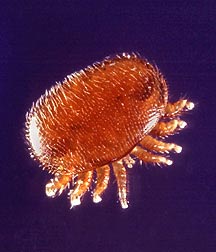
Colonies infested with the mite typically include bees with deformed wings, total paralysis and a destroyed immune system, leaving the bees vulnarible to bacteria and virusses. Colonies collapse due to the mites outproducing the bees, weakening colonies severely to the point of death in winter..
A colony gets infected by Varroa mites by adults mites hitchhiking on the back of workers or drones, making mating flights or collecting honey or pollen. The Varroa stays on the back of it's host untill it is set for reproduction, or until it finds another healthier host (which contributes to the spreading of virusses). This stage is called the 'protic' stage, where it only feeds itself. The Varroa is set for reproduction as soon as it can find a bee brood cell of around 5 days old (bee larva live in 'brood' cells). This stage is called the 'reproduction' stage, where the reproduction and growing of age of new mites takes place.
Note that this stage is important for the project, as this stage is very specific and can be used to target and eliminate infected brood cells. The picture below indicates the reproduction cycle for Varroa mites.
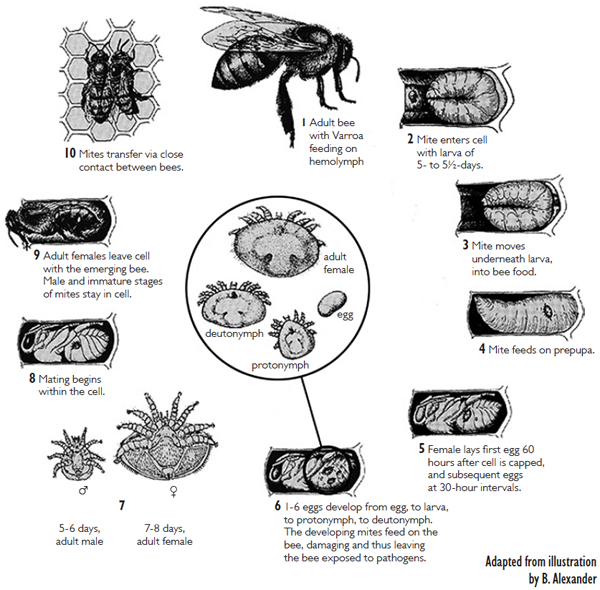
As can be seen in step 3, the mite hides behind the larva in the bee food. It hides untill the workers cap the brood cell with pollen and honey. The Varroa starts feeding on the larva and lays it's first egg 60 hours later. As the larva grows, more eggs get layed (usually around 6) and eventually hatch. The young mites also start feeding and grow into adults. Finally the severely weakened adult bee leaves the cell and with it new mites.
Other Pathogens
There are a lot of other pathogens, in addition to the Varrao mite, that may influence the health of a honeybee. Examples include Nosema, American foulbrood, European foulbrood and chalkbrood. Take for example American foulbrood. This disease is caused by the spores of the Paenibacillus larvae. Bee larvae are most susceptible to this infection and will become infected by spores present in their food. When other bees try to remove the spore-laden dead larvae, they unknowingly contaminate the rest of the hive. Since the spores are very persistent and can survive to up to 40 years it is fairly difficult to eliminate this disease.
Insecticides
Insecticides, in particular neonics, have also played a role in the decline of bees. Neonics are a class of neuroactive insecticides and are one of the most used insecticides around the world. Neonics however severely affect the honeybees' ability to forage and remembering routes to and from food sources. The use of insecticides has also been linked to CCD.
Poor nutrition
Intensified agriculture and climate change have led to a decreasing amount of food resources for honeybees. This lowers their resistance to diseases and pesticides. Some pathogens directly influence a bees’ nutrition. For example, the earlier mentioned parasite Nosema competes with the host bees for carbohydrates. This is one of the main nutrients bees need to survive. A mixed pollen diet is much better for a honeybee than a single pollen diet, as it increases their immunity to this kind of infection. Also, well-nourished honeybees are a lot better at detoxifying pesticides.
Climate change
Climate change has effected bees in a multiple of different ways. For one, climate change affects flowers and their nectar production. This in turn immediately influences the honeybees ability to collect pollen and sustain their hive. Additionally climate change induces more extreme weather events, such as prolonged drought or increasingly more rain. The flowers in environments experiencing drought may dwindle, while increasing rainy weather might wash away pollen.
Current Solutions
Chemical measures
Now-a-days, most beekeepers control their mite investation by using chemical measures. Apivar, Apistan and Checkmite+ are some popular chemical used in mite control. Discussed is the effectiveness, advantages, disadvantages and considerations of using chemical mite control. As the Varroa mite is a real killer and thus a wide-spread problem for beekeepers, beekeepers usually feel forced to use chemical mite control, knowingly risking severe drawbacks. It is not unreasonable, since chemical treatment has an effect of killing the mite population ranging from 75% up to 99% depending on mite resistance, moment of treatment and chemical used. If chemicals are used on non-resistant mite, generally all mites will die off. Resistant mites usually require specific chemicals to be used during winter when mites (and bees) are most susceptible.
However, with highly effectiveness come major drawbacks. Since the chemicals are often either highly acid, exothermic or poisonous, not only mites get affected. These chemical’s mode of action usually is fumigant or via contact, causing the whole bee population to be affected. Again depending on the chemical used and moment of use, bee colony losses range from 25%-40%. Bees might not be able to overwinter by deformation of wings or food poisoning (as most of the chemicals have a long half-time and get mixed into honey). Bees also tend to leave the hive and die eventually from starvation or freezing. With acid treatment, the beehive also has a chance to be corroded away by the chemical. Finally, a serious weakened queen (or even death of the queen) can be a probable cause of colony death. It should also be noted that chemical treatment often can often only be exercised once or twice a year.
As seen, chemical mite control can be really effective, but comes with a lot and severe consequences. Consequences not only in bee death, but also in quality of bee life. So is there an alternative?
Non-chemical measures
Bottom Screen Board
There are non-chemical measures. However these have either a real slim rate of effect or require close manual monitoring and manual actuation. The most commonly used measure is using a Screen Bottom Board. This method relies on mites falling of bees which randomly happens to mite sometimes, especially in cold hives (thus northern areas). The mites fall through the screen (bees cannot pass through) and fall on a sticky floor from which they can not escape, thus starving eventually. The advantage is that it is a passive method, works all year round and is really good in combination with chemical treatment. However, the rate of effect without chemical treatment only is up to 10%. It also might attract scavengers intruding the hive.
Drone Brood Excision
An active method is Drone Brood Removal. Varroa mites prefer drone brood cells for reproduction. Before drone brood cells get capped, a Varroa mite hides in the cell. When the cell gets capped, the mite comes out of hiding and starts feeding on the brood while reproducing itself. This method invokes on the beekeeper remove capped brood cells 2-3 times with an 28 days interval. This gives the mite no chance to reproduce. Effect can be over a 30% better survival rate and is really inexpensive. Although effective, colonies are weakened since there is only a few drones in operation, making the colony susceptible. More problematic is the labor intensive and time consuming process. It is a timely manner to remove and clean all capped drone cells and tricky time management wise to exactly act on a 28 days interval especially when the hives are placed remotely.
Requeening
A final, effective but tricky method is Requeening. Some species like the East-Russian Primorsky is genetically effective in cleaning hives and eliminating mites (Varroa Sensative Hygiëne (VSH)). The new queen of such a specie produces bees with such property and thus killing the mites. Effectiveness depends on the VSH specie and on the specie that it is introduced to. This method is fairly new, but an exciting heads-up is that the effect when a VSH specie is introduced to Buckfast bees, effectiveness ranges up to 90%. For Caucasian hybrid bees, this is 40%. The tricky part however is to get the new queen introduced to the colony. But even still, there is no satisfying answer to mite treatment.
A Possible Solution
MiteZaper
Inspired by the Brood Removal Method, we look for a method to eliminate the time consuming, labor intensive work. A honeycomb automatically removing capped drone brood cells. A predecessor of this method already exists: The MiteZapper. The MiteZapper is a honeycomb connected to a 12 volt battery. The MiteZapper shocks the comb with electricity 4-5 times with an 18-23 days interval. The bees then clean the frame since all brood and mites have died from the shocks. When cleaned, new eggs will be layed. A disadvantage is that it kills everything touching the frame, whereas preferably it would only kill capped brood cells.

This is where our technology could improve on. Our suggested method is that automatically only capped brood cells get emptied, either by electricity, fire, freezing or physical removal (must be further researched and given feedback by beekeepers). Even more preferable would be emptying only cells that contain Varroa mites. The problem then becomes detecting an (infected) capped brood cell.
The Proposed Solution
Mite/Cell Detection Problems
One detection method we thought of would be to measure pH in all cells. Varroa mites defecate a 95% guanine substance, which is basic. Would a cell turn basic, the system should identify this as an infected brood cell and thus should act on this. However, measuring all cells for their pH value would be a problem on its own. Measuring pH is hard and expensive, let aside the tight workspace available. Another problem with measuring pH is that although Varroa mite tend to defecate on the sides of the cell, an exact hit on the sensor might not have a high percent of happening. The sensor could also get covered in brood food, honey or pollen rendering the sensor useless. Another thought of solution would be laser sensing. Honey, pollen and worker brood cells are all capped flat, whereas a drone brood cell gets capped with a high dome. If lasers are placed along the sides of the frontside of the comb, the laser can measure if something is build out of the cell, like a drone brood dome capped cell. It would obstruct the laser for an 8 day period (capping time of a drone). So if a laser is obstructed for a long period of time, it could sense where the capped cell is and the system could now act on it. Downside is that it would kill all drone cells, infected or not.
The best solution would be to be able to detect if a mite has entered the cell, capped or not. A possible solution is that Varroa mites tend to hide in the brood food at the bottom of the cell as seen in the reproduction figure at step three. If somehow the appearance of a mite in the brood food could be detected automatically, the system can act on the mite and all will be solved. It could even be possible to kill the mite without harming the brood. However, no method is thought of yet to do this.
The PH Method
Because the laser method is unreliable because of bees crawling over the combs, the PH method is the most reliable. To sum up the issues to overcome with the method, a list is given:
- The PH sensor has to fit in the given space
- The excreted mite guanine must be in contact with the PH sensor
- The PH sensor has to be sensitive as to differ from a positive or negative reading of guanine
Sensor position
The sensor has to be positioned such that it both tackles the problem of fitting in the given space, and come in contact with the guanine. To come in contact with the guanine, the sensor has to be placed at a specific position in each cell. As can be seen in the figure below, guanine excreetion takes place at a specific position in the cell. This is fortunate for us, since we now know where to position the sensor. The specific position of guanine deposit is because the mites don't
Contact with a user
To develop a new system such as this electronic beehive, we also need to ask future users for their input. Since beekeepers are most familiar with the actual problems concerning the extinction of bees, we need to find out what they deem to be a proper usable (and practical) solution. Without this knowledge, the final product will become less applicable to the real world problem. It might become too expensive or it might introduce new problems that would otherwise have been pointed out by a future user.
To get a grip on what a beekeeper would want from an electronic beehive, we went to a local beekeeper in Nederwetten. This beekeeper had lost 80% of his honeybee population in the last winter. The main two reasons of this were the shortage of food in the close environment (bees fly up to 3 kilometers away from the hive) and the infections caused by varroa mites. Any beekeeper will be glad if there is a solution for the varroa mites, yet hobbyists will want this solution to be quite cheap, so it is affordable for them. Larger companies that employ honeybees (companies that are hiring beekeepers to move a colony to a desired location) might have a larger budget, but would still want a less costly solution.
The food shortage problem comes from a lot of factors. Farmers in the near vicinity might ruin the soil, such that earthworms will no longer be around. This then causes an error in the food chain, such that birds will also not come near the area. All in all, this leads to less food for the bees, and that is without even mentioning the pesticides used by farmers.
All in all, the need for a solution for the varroa mites is there, and every beekeeper would benefit from the use of that solution.
USE Aspects
Users
The users of this system consists mostly of beekeepers, who are given the responsibility of caring for the bees in the system. On a larger scale, companies might be interested in having a multitude of these systems, so that their employees (eg their own beekeepers) have to maintain them. These two groups are in direct contact with the system, such that the interface of the system is necessary knowledge for those groups.
Users that do not depend on the actual usage (and interface) of the system are for example gardeners or flowerists who want to have a beehive system nearby to aid the pollinating of their flowers. These stakeholders might hire someone to maintain the system for example, such that the purchasing and selling of these systems becomes a separate product or trade. Again, on a larger scale the ruling parts of provinces or countries might be involved with large-scale deployment of these systems, as to ascertain the survival of bees for our future.
Both these user groups have different needs towards such a beehive system.
Direct users want:
- The interface to the beehives to be easy to use and understand
- The usability of the beehives to be restricted to certain personnel
Owners of a beehive system (owning it for their own purpose but not directly using it) want:
- The system to be affordable
- The system to be easily placeable, and if possible to be compact
Finally, all users have the common need that the system should be reliable, so that the deployment of these systems helps in the survival of bees to some specified extent.
Society
Since the general problem our system is trying to fix (the dying of bees) is such a big problem for society, the effects our electronic beehive could have on society are similar in size. If these beehives are known to aid the survival of bees, societal parties like the government might employ these hives in large numbers.
This by itself will not create any ethical issues, however, our system is designed to kill off drones if there is a large quantity of varroa mites. This raises the question if it is ethically correct to do so, saving more bees in the progress. Currently the bad treatment of chickens in chicken farms is also a big topic, and if our beehive system would take off and be employed all over the world it might attract some attention to the artificial killing of bees as well.
Enterprise
From a business point of view the system is only worth affording for some company if that company has the need to help its bees survive. For example, florists (that depend on pollination by bees) do not really need such a system. They do want bees to pollinate their flowers, but for this they can hire a beekeeper, which is what mostly happens today. Beekeepers get hired to bring an aptly sized bee colony to a place where they can pollinate agricultural crops.
Thus we find that beekeepers might be interested in an electronic beehive, since they might prefer the ease of use and the lack of needed maintenance that such a system provides. These beehives could then also be shipped to some company that hire the beekeepers for the placement of bees.
As said above, governmental organisations might have an interest in helping bees in nature survive. These organisations might set up some foundation that employs these electronic beehives out in nature.
Models
Prototype
Requirements
In order to sustain the bee population against the growing danger of mites, a system is needed that monitors and acts on the bee colony and it's environment.
Information is essential for any smart system so it can act upon the data. The monitoring of a bee colony should be accurate, collecting a range of data like bee activity, humidity, temperature and most importantly, the monotoring of the bee colony should not interfere with the colonies well-being.
Secondly, the smart beehive must be able to act upon the information fed to the system via it's sensors. It should not only inform beekeepers on essential data, but should interact with the beehive itself as well. Our solution for the mite problem should be implemented, and maybe other features like changing temperature or humidity as well. These actuators have to be designed as to comfort the colony without any possible chance of inflicting damage to the colony (or beekeeper).
As said above, the system should be interactable by human as well. Information must be fed to the beekeeper for optimal beekeeping. This information stream must be desigend and an user-friendly interaction system should be included in the smart beehive. Optimally, the smart beehive should be modular, as to easily increase or decrease the capacity of the hive as needed by the beekeeper. A completely smart beehive is to be designed/prototyped and subjected to a series of test by expert and amateur beekeepers. Usability, effectivity, productivity and overall benefit are all to be assesed.
Build

Software Model
Requirements
The general idea of our model is that it is a piece of software that simulates the beehive, with introduction and elimination of varroa mites. This model will show us how well our system would help the honey bees survive, based on the hypothesis that we can detect and eliminate individual larvae that are infested with a varroa mite. The requirements are separated into different parts of the software.
GUI:
- The model must show the current state of the beehive
- The model must show a plotted graph of the state of the beehive from the start of the simulation up to the current point
- The model must have a start button, a stop button and a pause button.
- The model must show if the bee population in the hive in its current state is sufficient to survive
- The model's rate of simulation should be changeable
Modeling: Each entity (worker, drone, mite, queen and cell) should have a certain behaviour. Adult bees will fly outside and fly back into the hive, while younger stages of bees only have to grow and do not much else. Mites feed on bees, transfering between bees and spreading diseases. Female mites will move towards brood cells so that they can lay eggs. Younger mites only feed themselves on the brood that they grow up on. The queen bee will lay eggs at the same rate an average real life queen lays eggs.
Detection method:
Since we do not know how well our pH detection method will detect mites, we parameterize this, and we show in the end result the effects of our beehive on the population with different values of detection success.
Build
The software model is designed such that the modeling of the hive, drones, workers, queen, mites and cells does not depend on the way the model simulates time. This way the behaviour of individual entities can easily be modified. Time is simulated by means of 'ticks'. Each tick represents a number of hours (this amount can be changed on the gui), and the speed of these ticks (the amount of ticks per second, also changeable on the fly) ranges from 1 tick per second to 10 ticks per second.
Since we can monitor a lot of things in the hive, the visibility of certain data sets can be toggled on the fly.
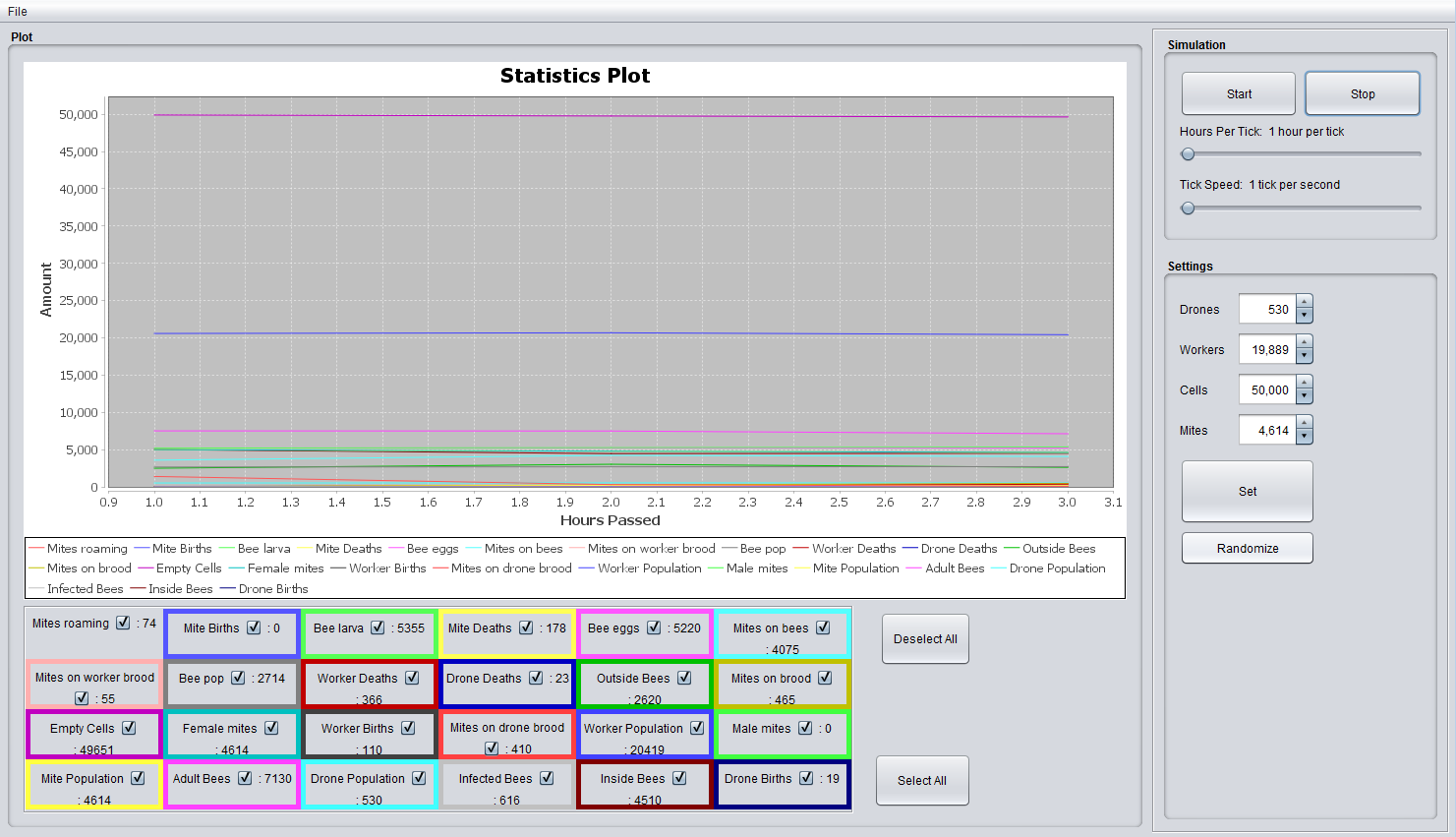
Behaviour
Bee eggs/larvae/pupilae
Depending on whether we have a worker or drone, we give them different lifespans and different times to grow up. They get a certain amount of time for each phase when they are born (lain as egg). These values are randomly generated from a normal distribution between a minimum and a maximum which are set beforehand. For drones these values are:
| Stage | Minimum Time | Maximum Time |
|---|---|---|
| Egg | 66 | 80 |
| Larva | 300 | 340 |
| Pupil | 150 | 170 |
| Adult | 504 | 2880 |
And for workers these values are:
| Stage | Minimum Time | Maximum Time |
|---|---|---|
| Egg | 60 | 72 |
| Larva | 170 | 240 |
| Pupil | 144 | 192 |
| Adult | 1008 | 5040 |
Drones
Drones have as only function to fertilize a queen. For this they take mating flights, and thus we model them to leave the hive to fly outside with a probability of 0.5, while flying back inside happens with a probability of 0.7.
Workers
Workers normally tend for the hive and queen, but we abstract from that by leaving food/water resources out of the picture, as well as tending for the queen. Workers are also only modeled to fly in or out of the hive, however they have different probabilities. Flying outside happens with probability 0.3 while flying inside happens with probability 0.8.
Mite Eggs
Mite eggs are lain in the brood cell where a fertilized female mite is feeding on a bee larva. These eggs (either male or female) only feed on the bee brood, sucking hemolymph out of it and giving it a shorter lifespan. Damage done by mites reduces a bee's adult lifespan (every hour it may reduce the adult lifespan between 100 and 500 hours.
Male Mites
Male mites do not have any other function than to feed on bees, so when they are in a cell without bee brood they try to transfer (or climb) to bees that are inside the hive. If there is bee brood inside the cell, they feed on that bee. If male mites are on an adult bee that is either inside or outside the hive, they try to transfer between bees.
Infections
Both male and female mites have a chance of causing an infection in a bee they are feeding on (this happens with probability 0.1). A bee will spread this infection to other bees with probability 0.01 every hour. Infections deal a lot less damage than mites however (between 5 and 50 hours), and will cause more deaths on the long term.
Female Mites
Female mites have a much larger role than male mites. They will more actively search for brood cells so that they can lay eggs. They will lay eggs after about 60 hours inside a brood cell, about every 30 hours. These timings are slightly randomized for variation as well.
Mites
When mites make an unsuccesfull transfer between bees or cells, they will be in a state where they have one chance to "climb back up", so as to model the falling of mites through the perforated bottom or falling on the ground outside. They succeed with a probability of 0.2.
Queen
Since modeling swarming or requeening felt quite unnecessary for the purpose of this simulation, we model the queen as invincible, although it will lay a constant amount of eggs, just as much as an average real queen would. This amounts to a minimum of 40 eggs per hour and a maximum of 80, where 1 to 25 percent of those eggs will be drone eggs. The balance between workers and drones is something that comes with the season and changes during the year. We do not model this, so that is why we picked those 'in-between' values for this egg laying balance.
Cells
Every 72 hours, all cells will activate their pH sensors to check for mites. To get an idea for how well our pH sensors should work (true positives) we parameterized this detection chance, and let multiple simulations run with varying detection chances.
Results
Since we chose a pH value based solution for detecting mites in a cell, and we could not get our hands on such a pH sensor ourselves, we do not know how accurate these sensors would be able to detect mites. To get an idea of how well we want these sensors to work, we parameterized the detection chance in our model, such that we can set the number of true positives (and false negatives) ourselves. We ran multiple simulations, each with the same start: 20000 workers, 500 drones, 50000 cells and 2000 mites. We let this simulation run for 6 weeks, after which we determined the number of alive adult bees and the size of the mite population.
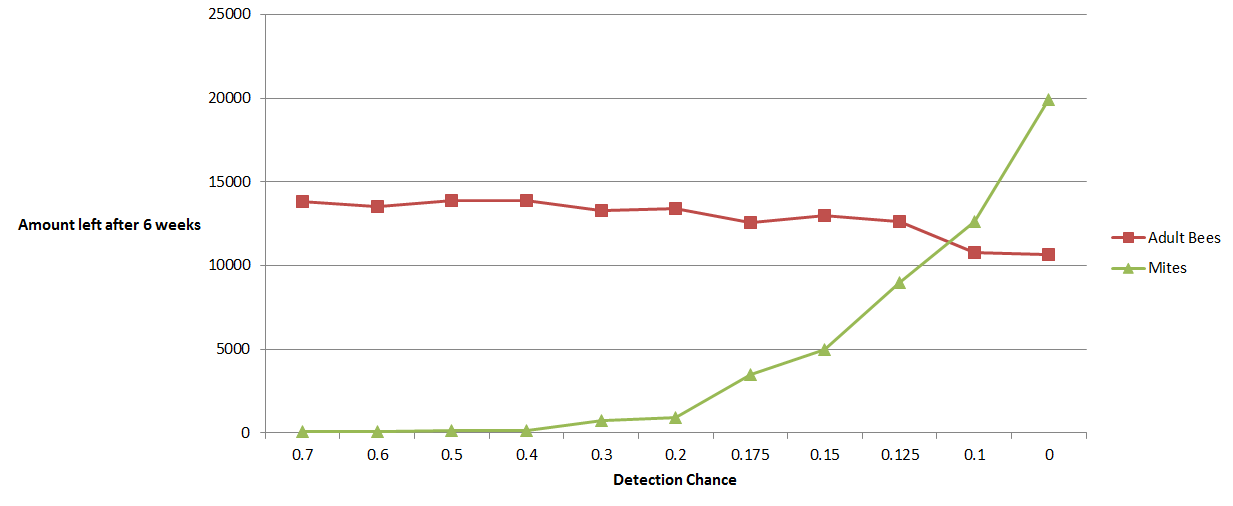
We can see that with more than 30% detection chance the mites will not have been able to keep up with the killings. The mite population has to thrive on the female mites laying more eggs, but this way they can't survive and quickly get subdued. Without any excision (0%) the mites will overpopulate the hive quickly, and at that point the hive will not be able to recover.
If we can design a custom pH sensor or if we have another method that will be able to detect correctly 20% of the time, we can reduce the mite problem to a significant degree, aiding the bee population.
Below are two simulations done to show the difference in adult bee/mite populations when either of them is getting the overhand.
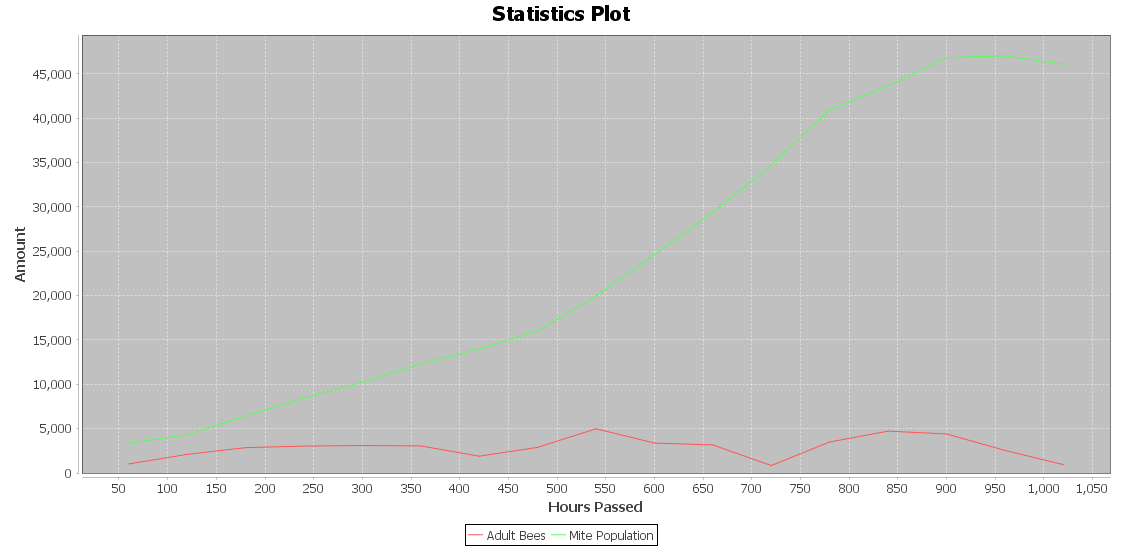
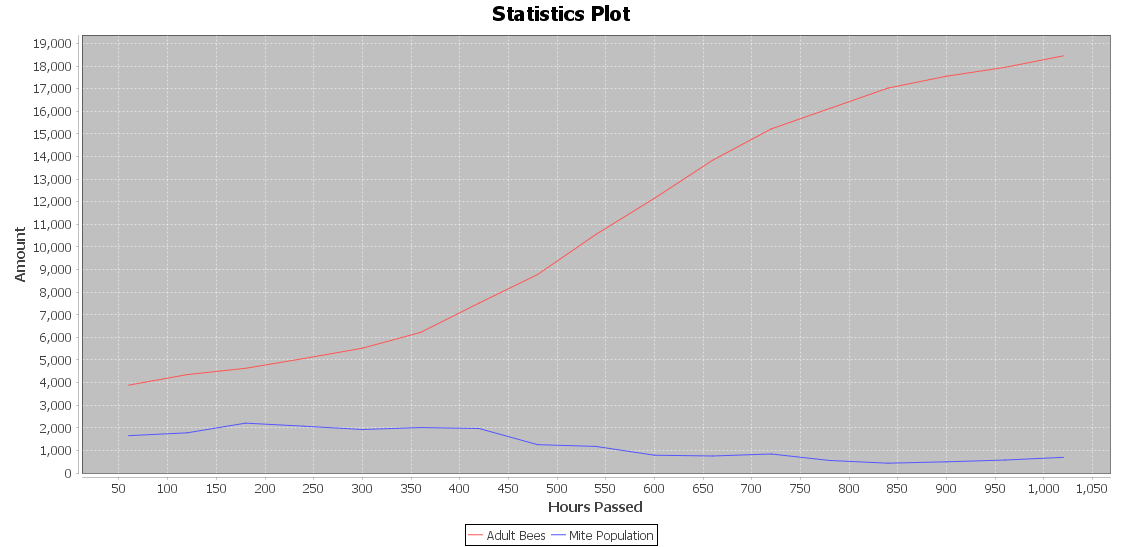
Conclusion
Further Research
References
https://honeybeesuite.com/what-is-guanine/ http://entnemdept.ufl.edu/creatures/misc/bees/varroa_mite.htm https://en.wikipedia.org/wiki/Colony_collapse_disorder http://beesmarttechnologies.com/about/ http://articles.extension.org/pages/65450/varroa-mite-reproductive-biology http://scientificbeekeeping.com/first-year-care-for-your-nuc/ https://en.wikipedia.org/wiki/Guanine http://www.sussex.ac.uk/lasi/resources/education/whatbeesdo/beebehaviour#Egg Laying http://honeybeehealthcoalition.org/wp-content/uploads/2015/08/HBHC-Guide_Varroa-Interactive-PDF.pdf http://www.mitezapper.com/How-it-Works_c_19.html http://www.fao.org/docrep/t0104e/T0104E05.htm